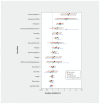Symptoms associated with a positive result for a swab for SARS-CoV-2 infection among children in Alberta
- PMID: 33234533
- PMCID: PMC7774482
- DOI: 10.1503/cmaj.202065
Symptoms associated with a positive result for a swab for SARS-CoV-2 infection among children in Alberta
Abstract
Background: Research involving children with severe acute respiratory syndrome coronavirus 2 (SARS-CoV-2) infection has primarily focused on those presenting to emergency departments. We aimed to determine the symptoms most commonly associated with a positive result for a SARS-CoV-2 swab among community-based children.
Methods: We conducted an observational study among children tested and followed for SARS-CoV-2 infection using nasal, nasopharyngeal, throat or other (e.g., nasopharyngeal aspirate or tracheal secretions, or unknown) swabs between Apr. 13 and Sept. 30, 2020, in Alberta. We calculated positive likelihood ratios (LRs) for self-reported symptoms and a positive SARS-CoV-2 swab result in the entire cohort and in 3 sensitivity analyses: all children with at least 1 symptom, all children tested because of contact tracing whether they were symptomatic or not and all children 5 years of age or older.
Results: We analyzed results for 2463 children who underwent testing for SARS-CoV-2 infection; 1987 children had a positive result and 476 had a negative result. Of children with a positive test result for SARS-CoV-2, 714 (35.9%) reported being asymptomatic. Although cough (24.5%) and rhinorrhea (19.3%) were 2 of the most common symptoms among children with SARS-CoV-2 infection, they were also common among those with negative test results and were not predictive of a positive test (positive LR 0.96, 95% confidence interval [CI] 0.81-1.14, and 0.87, 95% CI 0.72-1.06, respectively). Anosmia/ageusia (positive LR 7.33, 95% CI 3.03-17.76), nausea/vomiting (positive LR 5.51, 95% CI 1.74-17.43), headache (positive LR 2.49, 95% CI 1.74- 3.57) and fever (positive LR 1.68, 95% CI 1.34-2.11) were the symptoms most predictive of a positive result for a SARS-CoV-2 swab. The positive LR for the combination of anosmia/ageusia, nausea/vomiting and headache was 65.92 (95% CI 49.48-91.92).
Interpretation: About two-thirds of the children who tested positive for SARS-CoV-2 infection reported symptoms. The symptoms most strongly associated with a positive SARS-CoV-2 swab result were anosmia/ageusia, nausea/vomiting, headache and fever.
© 2021 Joule Inc. or its licensors.
Conflict of interest statement
Competing interests: None declared.
Figures


Comment in
-
Preventing the introduction of SARS-CoV-2 into school settings.CMAJ. 2021 Jan 4;193(1):E24-E25. doi: 10.1503/cmaj.202568. Epub 2020 Nov 24. CMAJ. 2021. PMID: 33234534 Free PMC article. No abstract available.
-
Comment empêcher le SRAS-CoV-2 d’entrer dans les écoles.CMAJ. 2021 Feb 1;193(5):E198-E199. doi: 10.1503/cmaj.202568-f. CMAJ. 2021. PMID: 33526553 Free PMC article. French. No abstract available.
References
-
- Wu Z, McGoogan JM. Characteristics of and important lessons from the coronavirus disease 2019 (COVID-19) outbreak in China: summary of a report of 72 314 cases from the Chinese Center for Disease Control and Prevention. JAMA 2020;323:1239–42. - PubMed
Publication types
MeSH terms
LinkOut - more resources
Full Text Sources
Medical
Miscellaneous
